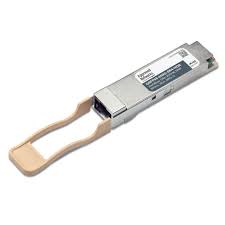Demystifying the 200G QSFP56 SR4 HDR Optical Module: The Ideal Choice for High-Performance Computing Centers

As artificial intelligence (AI), scientific research, and large-scale data analytics continue to evolve, high-performance computing (HPC) centers are facing unprecedented demands for faster and more efficient data exchange. At the heart of this performance race lies the need for low-latency, high-bandwidth interconnect solutions. InfiniBand HDR (High Data Rate), offering up to 200Gbps per link, has become a go-to interconnect for these intensive computing environments. Among the modules that enable this speed and scalability is the 200G QSFP56 SR4 HDR optical transceiver—a compact, high-speed solution optimized for short-range, high-density connectivity. This article explores what makes this module essential for modern HPC centers.
What is the 200G QSFP56 SR4 HDR Optical Module?
The 200G QSFP56 SR4 HDR optical module is a hot-pluggable transceiver designed to support 200 Gigabit Ethernet and InfiniBand HDR connectivity over multimode fiber (MMF). The “QSFP56” refers to the Quad Small Form-factor Pluggable 56, an enhanced version of the QSFP28, which supports up to 50Gbps per lane using PAM4 (four-level pulse amplitude modulation) encoding. With four lanes operating simultaneously, the SR4 variant achieves a total bandwidth of 200Gbps.
The “SR4” denotes a short-reach 4-lane module that uses an 850nm wavelength to transmit data over OM4 or OM5 multimode fiber, with a typical reach of up to 100 meters. It features an MPO-12 connector and is ideal for intra-rack or intra-data center links. When paired with InfiniBand HDR switches and host adapters, this module delivers high-throughput, low-latency connectivity suited for compute-intensive workloads.
The Role of the 200G SR4 Module in InfiniBand HDR Networks
InfiniBand HDR is specifically engineered for ultra-high-performance interconnects, offering both speed and efficiency. With 200Gbps data rates and support for Remote Direct Memory Access (RDMA), InfiniBand HDR networks significantly reduce latency and CPU overhead, making them far superior to traditional Ethernet in HPC scenarios.
The 200G QSFP56 SR4 module acts as a key enabler in this architecture. It connects servers, storage systems, and switches within the HPC environment, maintaining low-latency communication and maximizing bandwidth utilization. For applications like deep learning and real-time simulation, where inter-node communication must happen in microseconds, this level of performance is critical.
Moreover, the module supports advanced features such as forward error correction (FEC), ensuring reliable data transmission even in dense, high-interference environments. Its plug-and-play compatibility with HDR switches and network interface cards (NICs) further simplifies deployment and scaling.
Advantages in High-Performance Computing (HPC)
The 200G QSFP56 SR4 module offers several key advantages that make it a perfect match for HPC applications:
High Bandwidth for Parallel Processing
HPC workloads often require simultaneous data exchanges between thousands of nodes. The 200G SR4 module delivers enough bandwidth to support massive parallelism, ensuring faster computation and data aggregation across distributed systems.
Ultra-low Latency for Real-Time Results
Latency is one of the most critical performance metrics in HPC. The SR4 module, working within the InfiniBand HDR framework, enables latency levels far below those achievable with standard Ethernet. This is particularly important in time-sensitive tasks such as AI inference and scientific modeling.
Cost-Effective for Short-Range Deployments
Compared to long-range solutions like DR4 (200G over single-mode fiber), SR4 modules are more economical for short-distance connections. This makes them an excellent choice for data centers where server racks and switches are typically located within the same facility.
Scalable and Future-Ready
With support for PAM4 and the QSFP56 form factor, SR4 modules provide a future-proof path for scaling up without rearchitecting the entire infrastructure. They offer high port density and are backward-compatible with existing InfiniBand setups, allowing for gradual network upgrades.
Typical Application Scenarios
AI Training Clusters
In AI training environments, multiple GPUs across different servers must communicate quickly and efficiently to train large-scale neural networks. The 200G QSFP56 SR4 module provides the necessary bandwidth and low latency to support real-time gradient exchange, model updates, and data synchronization.
For example, platforms like NVIDIA DGX systems and AI supercomputers often rely on InfiniBand HDR networks using SR4 modules to achieve optimal performance during deep learning model training.
Supercomputing Centers
Supercomputers often consist of thousands of interconnected nodes performing highly parallel computations. The 200G SR4 module ensures ultra-fast inter-node communication, enabling the system to perform complex tasks such as climate modeling, molecular simulation, and physics calculations.
Leading HPC institutions on the TOP500 list have adopted InfiniBand HDR and QSFP56 SR4 modules to maintain their competitive edge in computational performance.
Financial Services and Real-Time Analytics
Low latency and high throughput are essential in financial computing, where milliseconds can equate to millions of dollars. The 200G QSFP56 SR4 module plays a critical role in ensuring real-time data processing and transaction execution across high-frequency trading platforms and real-time analytics systems.
Conclusion
As the demand for compute power continues to rise, the need for robust, scalable, and high-speed interconnects becomes even more crucial. The 200G QSFP56 SR4 HDR optical module emerges as a vital building block in this evolution, offering the perfect blend of performance, efficiency, and cost-effectiveness for high-performance computing environments.
Whether it’s driving AI training clusters, supporting scientific research, or enabling lightning-fast financial computations, this module delivers the speed and reliability needed to push the boundaries of what’s possible in modern computing. Choosing the right optical module is no longer a back-end decision—it’s a strategic step toward a faster, smarter, and more connected future.



